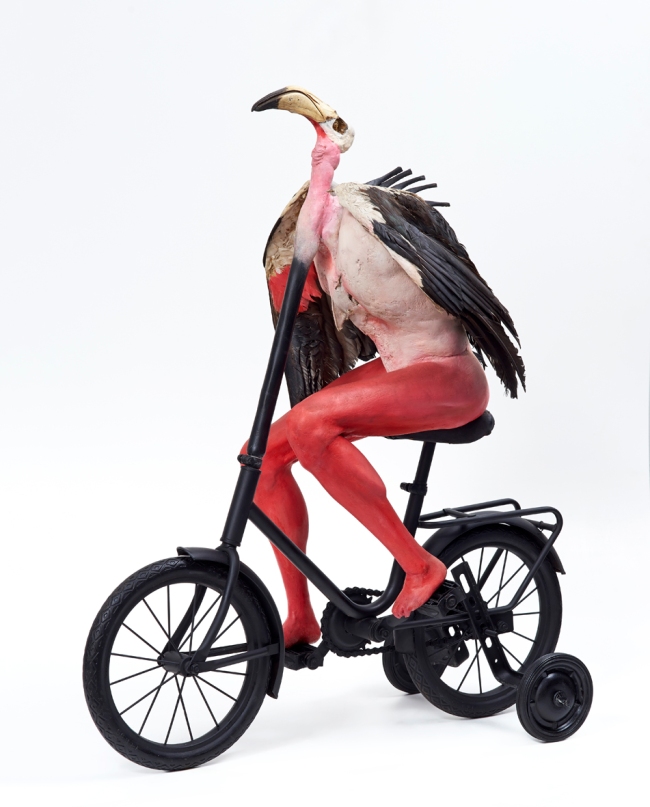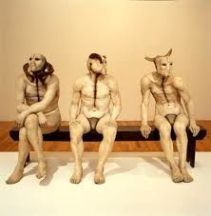Jane Alexander’s Invisible Reality on the Auction Floor at Strauss and Co. in Johannesburg, South Africa
I have not lived in South Africa for 40 years though I grew up here. I wrote this piece after seeing the work in a press release. When I received the catalogue the interpretation from a South Africa perspective was very different. I had not linked the hybridity of her creatures with the complex ethnic mix of South Africa or tension between racial groups. It is true there are layers of meanings in these works I have not addressed. My interpretation is based on viewing Jane Alexander outside of her time and place. This is how I see her works.
Jane Alexander ranks with other great 20th Century artists who set out to show the duality of life in which the official perception of everyday reality is independent of the reality of the imagination. It is the reality of the imagination, of a higher reality, that penetrates far beyond what the eye can or wants to see. Under oppressive regimes; in response to atrocity; or social decadence art plays a vital role in society in challenging the status quo. Jane Alexander ‘s two works coming to auction at Straus and Co. in Johannesburg–“Untitled” and “West Coast African Angel” – present themselves as part of a 20th century artistic dialogue where the viewer is not invited to read recognizable art forms or imagery, but to cross over to a reality otherwise invisible. Anselm Kieffer’s abstract canvasses filled with his own indigenous set of subjects and symbols explore the unseen reality of the fraught territory of German history.
Russian Non-Conformist art starting in the 1960s in Soviet Russia was doubly real because it had no relation to reality and it challenged the status of official artistic reality.
Dmitry Krasnopevtsev, Still life, stones and skulls (1962).
When in became accepted in the 1970s it was the beginning of the end of the Soviet Regime. Franics Bacon invited experience of inhumanity through his portraiture of some of the most iconic images of wounded and traumatized humanity in post-war art. His subjects were always portrayed as violently distorted, presented not as sociable and charismatic types but as isolated souls imprisoned and tormented by existential dilemma. Jane Alexander makes possible, through her sculptures, intense experience of inhumanity and the bestial in man.
Working in the 80’s in South Africa Jane Alexander observed and experienced the increasing conflict and violence between Afrikaans oppressor and the black oppressed. Apartheid, which had segregated white from black since 1948, had by the 1980s reached a crises point. Refusal to accept the degradation of the previous generation, black youth formed subversive groups and with increased protest challenged a system that was intolerable in modern society. Reacting against this threat to the existing establishment, the Afrikaner government became more ruthless, more brutal.
In Untitled, due to be auctioned on November 11th, Alexander places a life-size burly figure in a wooden armchair. His decaying flesh is splattered with discoloration. At the rear, his skin is broken open to reveal his brain and spinal column. Draped over his neck is a leather and rubber strap – originally used in the Witwatersrand mines to secure a damaged body to a stretcher to hoist from a shaft. Deprived of a mouth, his face without expression, the figure can merely bear witness to the events in his view, unable to comment, protest, or condone. His eyes do not return one’s gaze but seem to drift off in view of something further, beyond his immediate reach. The placement of the figure on a chair resembles a man strapped to an electric chair, about to be obliterated. The work reaches beyond the gold mines of Johannesburg and its inhuman working conditions; beyond the pain of being black in an Apartheid regime; beyond the daily threat of harm. The work is universal in depicting human suffering. It reaches back to ancient Roman times. It addresses the ruler and the ruled. For the latter, savaged and broken, life is of no consequence. For the onlooker this work demands a crossing over from a reality that has seemingly been acceptable to a reality that exits and has been ignored. It is an invisible reality of the depths of inhumanity. In South Africa in the 1980s, this was particularly potent.
Not at auctions at Strauss and Co. but necessary to consider as the counterpart to Untitled is Jane Alexander’s Butcher Boys in the collection of Iziko South African National Gallery. The piece is composed of three life-size sculptures of eerily deformed men with animal horns sitting on a bench as if they are in deep thought. The experience for the viewer is one of discomfort and repugnance. But the work is not limited to its perceived intent of presenting the brutal dehumanizing forces of Apartheid. It could exist in any context addressing the bestial, naked animal forces in man.
The 2nd piece to be auctioned by at Strauss and Co. is Jane Alexander’s West Coast African Angel. Here a strange creature half bird, half man is frantically riding a bicycle. The creature which most closely resembles a flamingo, a bird normally serene – appears to be both transmuted and coming apart as the thin layer of feathers on its wings cannot support its ability to fly. The bicycle, on which it now relies, is so vital to its existence that the creature has allowed the ascending front bar to penetrate its neck, and the rod is what keeps its head upright. Its fragility encompasses us as we cross from the safe to the unsafe, and acknowledge our own angst in the real reality of our existence
Jane Alexander’s body of work adheres to the 20th century philosophy of art as an experience. The idea of art as an experience began with the breakdown of religious belief that accompanied 19th century industrialization and scientific innovations. Reacting against perceived crises with the emergence of a new modern society, some artists looked back to a pre-modern way of experiencing the world and explored immaterial experiences. However others, as the century progressed, adopted Symbolism, Surrealism, Abstraction, and later Pop as they prioritized the invisible, the unconscious, the irrational and the visionary. The mission of art became one of requiring the viewer to step from the known to the unknown. It requires a mental decision to see things differently. Crossing from the perceived real to what one can not see on one’s own allows for an inner enlightenment, a religious conversion.
Jane Alexander’s work cannot be described as art from the Continent of Africa. It is mainstream Contemporary Art. Whatever the price it achieves at Strauss and Co. on Nov 11th will be miniscule against its greater destiny.




